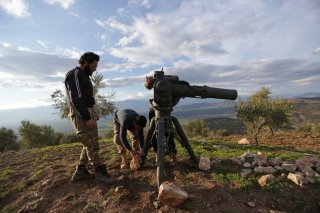This is the Army’s Best Bet for Destroying Incoming Anti-Tank Missiles
A technology already exists to determine the source of small arms fire.
Here's What You Need To Remember: RPGs and anti-tank weapons naturally generate a larger heat signal than small arms fire, and some of them operate at very long ranges—much farther than small arms fire in some instances. Merging acoustic and infrared detection, therefore, could compare or analyze an acoustic signature in relation to a heat emission to offer new levels of precision tracking.
When an enemy anti-tank guided missile (ATGM) is fired at a column of U.S. Army armored vehicles, endangering infantry carriers, tactical vehicles and even tanks, there can be few defenses unless the source of incoming fire can be quickly detected.
A technology which does this for small arms fire, made by a Raytheon subsidiary called BBN, already exists and has been deployed with U.S. Army soldiers. It’s called Boomerang, and a set of six different sensors can instantly find the source of incoming bullets from moving vehicles and stationary locations by tracking the acoustic signature of the enemy gunshot.
“The way a shock wave works is it generates and propagates at the speed of sound. While the bullet is moving, a stream of waves comes off the tip of the bullet that propagates through the air. From six sensors I can locate exactly where it came from,” Brad Tousley, President at Raytheon BBN, told The National Interest in an interview. “As a bullet travels down range, it generates a shock wave. The sensor locates the shock wave from the muzzle blast and the shock wave from the bullet.”
Raytheon is now applying this concept to sensors engineered to detect the origins of rocket-propelled-grenades (PRGs) and ATGMs. Development is now underway by Raytheon BBN to engineer a multi-mode sensor able to synthesize acoustic detection with infrared detection to precisely identify the sound and heat signature of various forms of hostile fire such as attacking anti-tank missiles and RPGs. RPGs and anti-tank weapons naturally generate a larger heat signal than small arms fire, and some of them operate at very long ranges—much farther than small arms fire in some instances. Merging acoustic and infrared detection, therefore, could compare or analyze an acoustic signature in relation to a heat emission to offer new levels of precision tracking.
Merging, analyzing and organizing otherwise disparate pools or streams of sensor data, such as those generated by infrared or acoustic sensors, aligns in a seemingly optimal way with ongoing Raytheon work on AI and Machine Learning applications, Tousley explained.
Advanced, AI-enabled algorithms can now, in near real time, discern multiple streams of sensor data, feed them into a vast database and instantly perform analyses, answer questions and generate possible solutions. Perhaps an infrared signature offers higher fidelity in a particular kind of attack? Better yet, perhaps renderings from a series of small acoustic sensors can combine with infrared signals to bring unprecedented levels of precision to a long-range incoming missile attack from miles away? What if an attacking round fires from a weapon which generates a heat signature much larger and more distinct than an acoustic signal? Or a weapon might also be engineered with some kind of advanced infrared suppressor and, by contrast, only generate a detectable acoustic signature? If an attacking weapon generates both, and the data is synergized, then perhaps detection can reach previously unavailable levels of precision.
Analysis can only be as effective as the database it operates with or draws from, a circumstance which explains why AI-empowered information systems can perform procedural searching and data-mining functions in seconds. All of this can be done by bouncing new, arriving information off of or against a seemingly limitless data repository. Not only that, but the computers can draw upon previous scenarios and analyze a number of otherwise disconnected, yet highly relevant variables in relation to one another such as wind speed, terrain, climate or the trajectory of an incoming projectile. This is where Machine Learning can bring new dimensions, as it involves a technical effort to perform near real-time analytics upon newly arriving, yet previously unrecognized information. Advanced algorithms can quickly integrate, analyze and help identify new details with the aim of placing them in context for presentation to a human decision-maker.
All of these calculations are engineered to, among other things, offer human commanders optimized choices for counterattack based upon a particular circumstance. For instance, perhaps certain weapons might be best suited to effectively respond to a particular attack? An AI-capable system could determine these kinds of informed solutions in many instances, based on its compiled database of prior circumstances and a host of interwoven, yet previously disaggregated variables.
Kris Osborn is the Defense Editor for the National Interest. Osborn previously served at the Pentagon as a Highly Qualified Expert with the Office of the Assistant Secretary of the Army—Acquisition, Logistics & Technology. Osborn has also worked as an anchor and on-air military specialist at national TV networks. He has appeared as a guest military expert on Fox News, MSNBC, The Military Channel, and The History Channel. He also has a Masters Degree in Comparative Literature from Columbia University.
Image: Reuters

